Enter the intriguing world of the Barred Buttonquail, an enigmatic bird species that defies conventional expectations. Unlike typical quails, this ground-dwelling bird, scientifically known as “Turnix suscitator,” captivates with its unique features and behaviors.
What sets it apart is the reversal of gender roles, where females boast vibrant plumage, challenging traditional norms.
Found across the grasslands of Asia and Europe, from Sri Lanka to China and Indonesia, these birds lead secretive lives, blending seamlessly into their surroundings.
Their cryptic coloration is effective camouflage, allowing them to forage for seeds and insects while evading predators.
Join us as we delve deeper into the captivating world of the Barred Buttonquail, a species that continues to intrigue and fascinate bird enthusiasts worldwide.
Physical Characteristics of Barred Buttonquails
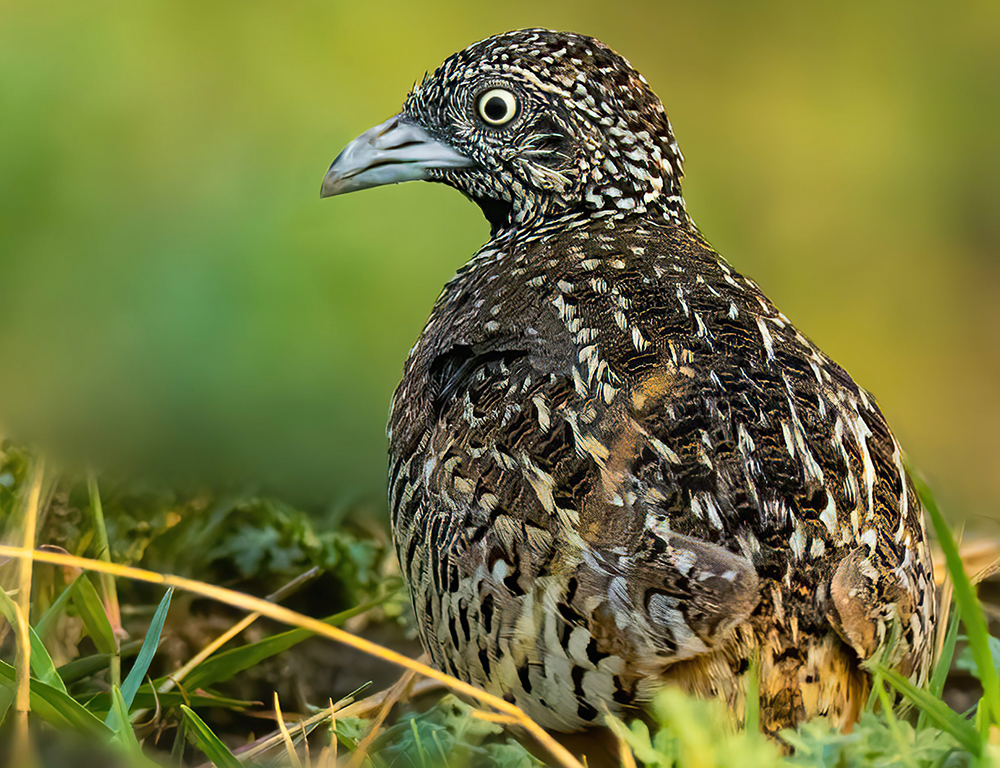
The Barred Buttonquail possesses several unique physical characteristics that contribute to its distinctiveness among bird species:
Size and Weight
Barred Buttonquails are relatively small birds, measuring 6 to 7 inches in height and weighing approximately 1.5 to 2 ounces. Despite their modest size, these birds are remarkably agile and well-adapted to their environment.
Plumage
One of the most striking features of the Barred Buttonquail is its mottled brown plumage. This coloration is excellent camouflage, allowing the bird to blend seamlessly into its natural surroundings.
The lighter underparts, often adorned with white or pale tan streaks, further enhance their camouflage, making them difficult to spot amidst grasses and shrubbery.
Facial Features
Barred Buttonquails possess dark eyes set deep within their tiny heads, providing them with a keen vision for foraging and navigating their habitat. Their sharp, pointed beaks are well-suited for cracking open seeds and accessing other food sources.
Legs and Feet
One of the most notable physical traits of the Barred Buttonquail is its robust legs, which terminate in three forward-facing toes. This adaptation is ideal for efficient ground-dwelling, allowing the bird to move swiftly and with agility across various terrains.
Sexual Dimorphism
Unlike many bird species, where males exhibit more vibrant colors, Barred Buttonquails display sexual dimorphism, with females showcasing richer hues on their feathers than males.
This distinctive characteristic adds to the visual diversity of the species and may play a role in courtship and mate selection.
Habitat and Distribution of Barred Buttonquails
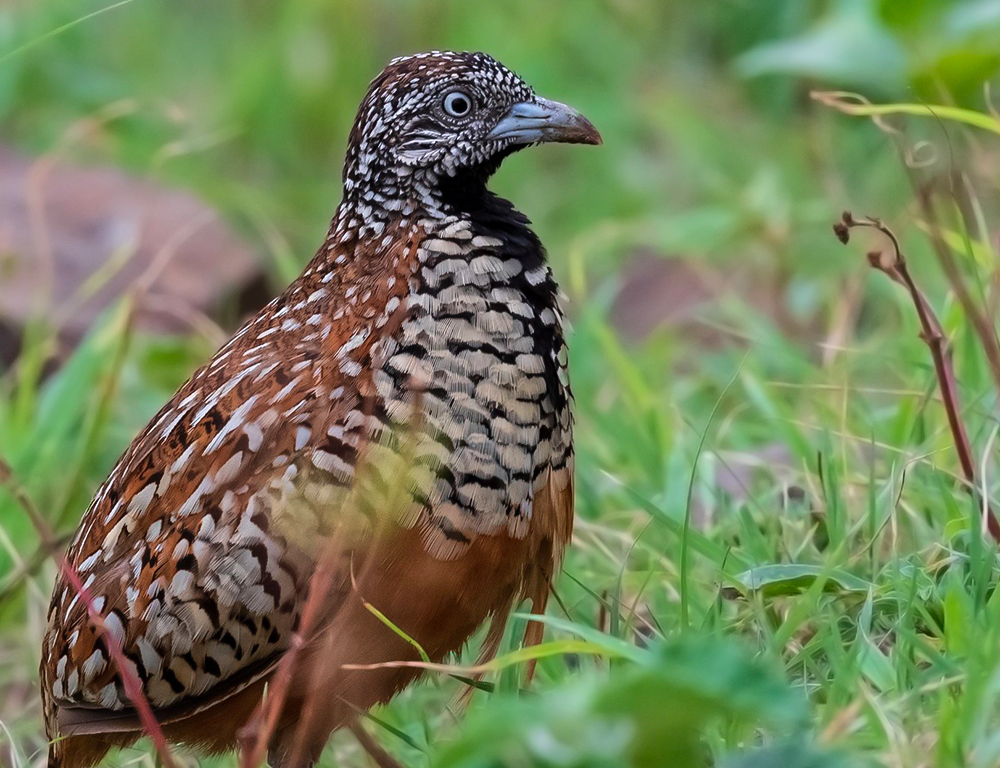
The Barred Buttonquail, scientifically known as Turnix suscitator, is a fascinating bird species with a wide habitat range across various parts of Asia.
Let’s delve into more detail regarding its habitat preferences and distribution:
Habitat Preferences
Barred Buttonquails exhibit remarkable adaptability to different habitats, provided they offer dense undergrowth for cover. Here are some habitat types where they can be found:
- Dry Grasslands: These birds are known to inhabit dry grasslands with sufficient vegetation cover to conceal themselves and provide nesting sites.
- Wet Marshes: Despite their name, Barred Buttonquails also inhabit wetter areas such as marshes, as long as dense undergrowth provides cover.
- Vegetated Areas: They thrive in dense vegetation, including scrublands, forest edges, and overgrown fields.
Distribution
The distribution of the Barred Buttonquail spans several countries in Asia. Here’s a breakdown of their estimated populations in some key regions:
- India: The species has a significant presence in India, with an estimated population ranging from 10,000 to 100,000 individuals. They can be found in various habitats nationwide, from grasslands to marshy areas.
- China: In China, the population of Barred Buttonquails is estimated to be between 1,000 to 10,000 individuals. They are found in southern regions of China where suitable habitats exist.
- Indonesia: While no specific estimate is provided for Indonesia, it is known that Barred Buttonquails are present in Southeast Asia, including parts of Indonesia where suitable habitat conditions are met.
Overall Distribution Pattern
The Barred Buttonquail exhibits a widespread but not particularly dense distribution pattern across its range. This suggests that while they are adaptable and can thrive in various habitats, their populations may not be concentrated in large numbers in any specific area.
Behavior
Barred Buttonquails are primarily ground-dwelling birds, preferring to forage on the ground for seeds and insects. They are not known for extensive flight and often rely on staying low and hidden amidst vegetation for protection.
Behavior and Diet of Barred Buttonquails
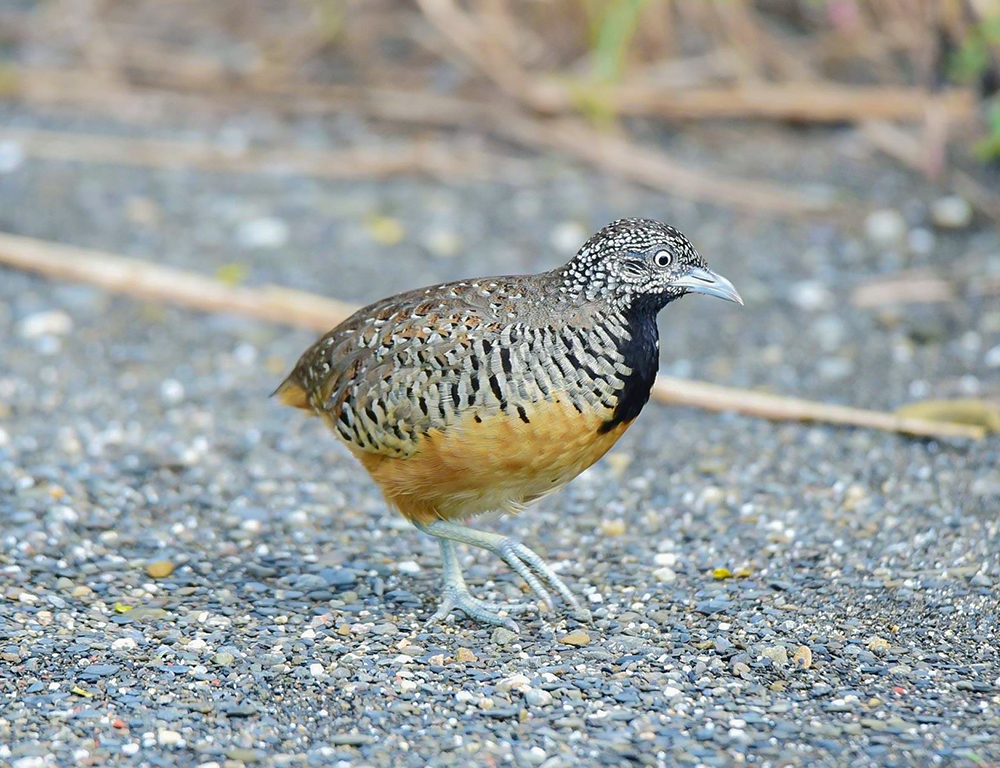
The Barred Buttonquail possesses fascinating behaviors and dietary preferences that set it apart in the avian world. Let’s delve deeper into its behavior and diet:
Behavior
- Terrestrial Nature: Barred Buttonquails are primarily terrestrial birds, meaning they spend most of their time on the ground rather than in flight. This behavior is reflected in their foraging habits and nesting behaviors.
- Role Reversal in Courtship: A distinctive characteristic of Barred Buttonquails is the role reversal in courtship behavior, where females court males. This behavior is uncommon among birds and adds to the species’ uniqueness.
- Territorial Defense: Female Barred Buttonquails are known to defend their territories fiercely, exhibiting aggressive behavior towards intruders. This territorial behavior helps ensure access to resources and suitable nesting sites.
- Incubation and Parental Care: During the breeding season, males are responsible for incubating the eggs and caring for the chicks once they hatch. This role reversal in parental care is another intriguing aspect of their behavior.
Diet
- Insectivorous Diet: Barred Buttonquails primarily feed on insects, constituting around 60% of their diet. They consume various insects, such as ants, beetles, and locusts, which provide essential protein and nutrients.
- Seed Consumption: Seeds comprise approximately 30% of the Barred Buttonquail diet. They supplement their insect-rich diet with seeds, which offer additional nutritional benefits.
- Plant Matter: Although less significant than insects and seeds, Barred Buttonquails consume plant matter, comprising about 10% of their diet. This may include various plant materials found on the ground or in vegetation.
Foraging Behavior
Barred Buttonquails exhibit strategic foraging behavior, often foraging at dawn or dusk when their prey is most active. This allows them to locate and capture insects while minimizing predation risk efficiently.
Reproduction and Life Cycle of Barred Buttonquails
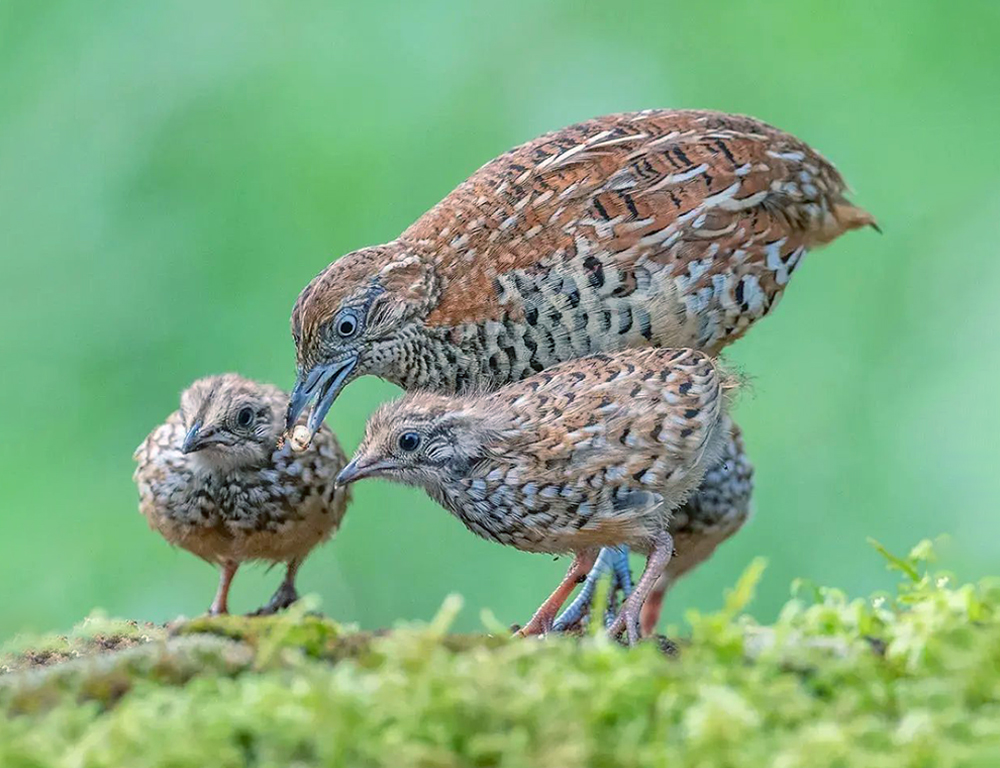
The reproduction and life cycle of the Barred Buttonquail are indeed fascinating and full of unique behaviors and adaptations:
Mating Season
The mating season for Barred Buttonquails typically spans from March to August, providing an extended period for finding suitable mates.
Courtship Rituals
During courtship, male Barred Buttonquails perform elaborate dances to attract potential mates. This behavior includes fluffing up feathers, strutting around, and making specific calls to catch the eye of females.
Egg Laying
Female Barred Buttonquails lay an average of 4-6 eggs per clutch. These eggs are typically pale cream or white with scattered spots, resembling tiny Easter eggs.
Incubation
Interestingly, it is primarily the males who are responsible for incubating the eggs. They diligently sit on the nest for about two weeks until the eggs hatch.
Parental Care
After hatching, the chicks grow remarkably fast. Within two days, they feed themselves, showcasing their quick learning abilities. By three weeks, they start showing signs of adult plumage, indicating their rapid growth into adulthood.
Independence
Despite their initially dependent state, Barred Buttonquail chicks quickly become independent, gaining the ability to feed themselves and develop adult-like plumage within a short period.
Conservation Status of Barred Buttonquails
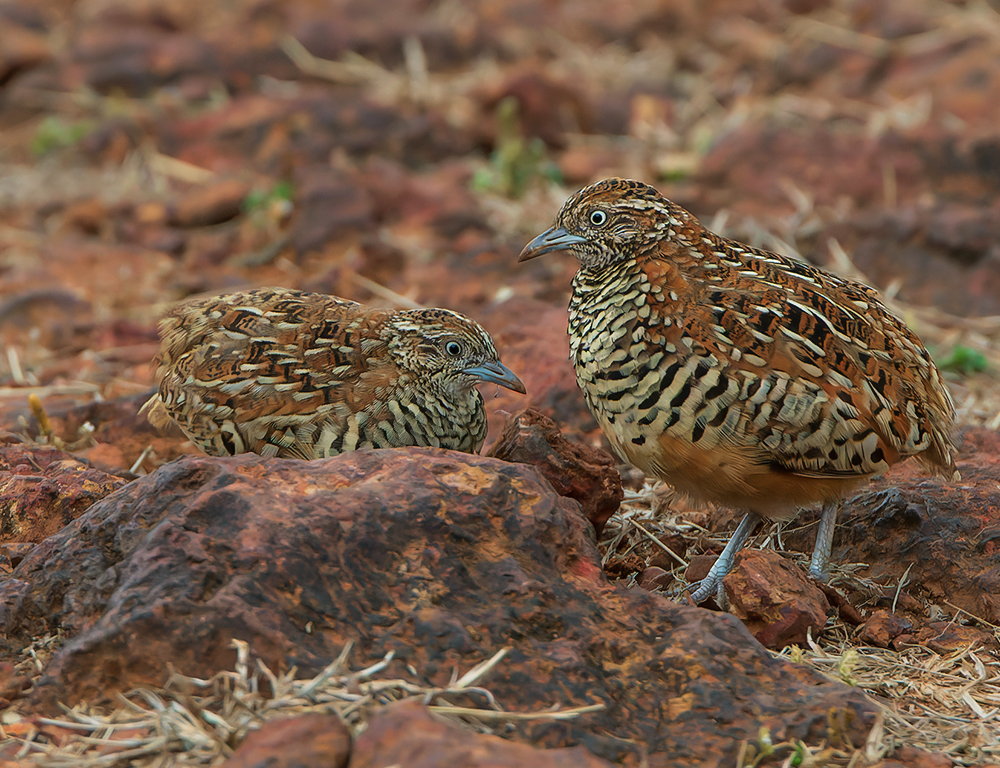
The conservation status of the Barred Buttonquail is currently assessed as “Least Concern” on the International Union for Conservation of Nature (IUCN) Red List. This designation indicates that the species is not facing significant threats to its survival.
However, it is essential to remain vigilant and monitor potential risks that could impact its population in the future.
Population Trends
Over the past decade, population estimates for the Barred Buttonquail have remained relatively stable, ranging from 67,000 to 134,000 individuals.
This stability in population trends is a positive sign, suggesting that the species can maintain its numbers.
Potential Threats
While the Barred Buttonquail is not facing immediate dangers, specific factors could pose risks to its population in the future. Habitat loss due to urban development and agriculture is one such threat that could impact the species’ long-term survival.
Ecological Importance
The Barred Buttonquail plays a crucial role in its ecosystem, contributing to seed dispersal and pest control. As such, preserving their habitat and ensuring their continued existence is essential for maintaining ecological balance.
Conservation Efforts
While no targeted conservation efforts are specifically for the Barred Buttonquail, general biodiversity action plans often include indirect measures that benefit the species.
These measures include preserving natural habitats and promoting sustainable farming practices, which help maintain suitable bird environments.
Conclusion
The journey into the world of the Barred Buttonquail reveals an extraordinary creature with unique characteristics and behaviors.
Despite its ‘Least Concern’ status on the IUCN Red List, the species faces escalating threats from habitat loss due to human activity.
Conservation efforts are crucial to safeguarding their habitat and ensuring their survival.
As we reflect on their fascinating reversal of traditional gender roles and their preference for undisturbed environments, it’s evident that public education and proactive conservation measures are vital.
Let’s pay attention to the declining population trend and take action to protect these remarkable birds. By preserving their habitats, we safeguard the Barred Buttonquail and contribute to the diversity and balance of our global ecosystem for generations to come.